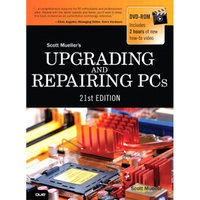Upgrading And Repairing PCs 21st Edition: Flash Storage
Sony Memory Stick, ATA Flash PC Card, And xD-Picture Card
Sony Memory Stick
Sony, which is heavily involved in both laptop computers and a variety of digital cameras and camcorder products, has its own proprietary version of flash memory known as the Sony Memory Stick. This device features an erase-protection switch, which prevents accidental erasure of your photographs. Sony has also licensed Memory Stick technology to other companies, such as Lexar Media and SanDisk.
Lexar introduced the enhanced Memory Stick Pro in 2003. Memory Stick Pro includes MagicGate encryption technology, which enables digital rights management, and Lexar’s proprietary high-speed memory controller. Memory Stick Pro is sometimes referred to as MagicGate Memory Stick.
The Memory Stick Pro Duo is a reduced-size, reduced-weight version of the standard Memory Stick Pro. It can be adapted to devices designed for the Memory Stick Pro.
Sony later released “Mark 2” certified versions of the Memory Stick Pro in 2008. This certification indicated that the cards were suitable for use with AVCHD (Advanced Video Coding High Definition) recording devices. Sony also released a smaller Memory Stick Micro (also called M2) format in 2006, which was designed to compete with microSD. In 2009 Sony announced the Memory Stick XC (eXtended Capacity) format in order to compete with SDXC.
Because the Memory Stick formats are proprietary and only used in Sony devices, I recommend avoiding them wherever possible. In order to avoid using expensive and hard to find proprietary memory, make sure any device you purchase accepts industry standard memory such as SD. Fortunately, Sony’s newer devices are including support for industry standard SD memory formats in response to the negative backlash against its proprietary Memory Stick.
ATA Flash PC Card
Although the PC Card (PCMCIA) form factor has been used for everything from game adapters to modems, SCSI (Small Computer Systems Interface) cards, network cards, and more, its original use was computer memory, as the old PCMCIA (Personal Computer Memory Card International Association) acronym indicated.
Unlike normal RAM modules, PC Card memory acts like a disk drive, using the PCMCIA ATA (AT Attachment) standard. PC Cards come in three thicknesses (Type I is 3.3 mm, Type II is 5 mm, and Type III is 10.5 mm), but all are 3.3-inch long by 2.13-inch wide. Type I and Type II cards are used for ATA-compliant flash memory and the newest ATA-compliant hard disks. Type III cards are used for older ATA-compliant hard disks; a Type III slot also can be used as two Type II slots.
xD-Picture Card
In July 2002, Olympus and Fujifilm, the major supporters of the SmartMedia flash memory standard for digital cameras, announced the xD-Picture Card as a much smaller, more durable replacement for SmartMedia. In addition to being about one-third the size of SmartMedia—making it the smallest flash memory format yet—xD-Picture Card media has a faster controller to enable faster image capture.
Both 16 MB and 32 MB cards (commonly packaged with cameras) record data at speeds of 1.3 MB/s, whereas 64 MB and larger cards record data at 3 MB/s. The read speed for all sizes is 5 MB/s. The media is manufactured for Olympus and Fujifilm by Toshiba, and because xD-Picture media is optimized for the differences in the cameras (Olympus’s media supports the panorama mode found in some Olympus xD-Picture cameras, for example), you should buy media that’s the same brand as your digital camera.
Just as with the proprietary Sony Memory Stick formats, I also recommend avoiding the proprietary xD-Picture card format wherever possible. Instead, I only recommend purchasing devices that use industry standard memory card formats such as SD. Because of the backlash against proprietary formats, Olympus and Fujifilm abandoned xD-Picture card in 2010.
Current page: Sony Memory Stick, ATA Flash PC Card, And xD-Picture Card
Prev Page CompactFlash, SmartMedia, And MultiMediaCard Next Page SSD (Solid-State Drive)Stay on the Cutting Edge
Join the experts who read Tom's Hardware for the inside track on enthusiast PC tech news — and have for over 25 years. We'll send breaking news and in-depth reviews of CPUs, GPUs, AI, maker hardware and more straight to your inbox.

